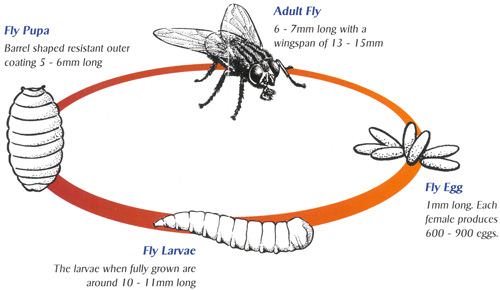There are 100,000 species of flies in the world. Most of them have the same life cycle and have an average life span of a month.
They can only be differentiated by their physical attributes, feeding habits or habitats.
Out of these 100,000 types of flies, housefly is the most common breed of flies found in our household.
And today, in this post, I am going to highlight some interesting facts about houseflies. But before that, lets have a look at the physical appearance of a fly.
Physical Appearance of a Housefly:
 Houseflies are usually gray in color and are about 4 to 8 mm long. The upper body (pro thorax) is covered with four dark gray stripes. The whole body of a house fly is covered with hair like projections.
Houseflies are usually gray in color and are about 4 to 8 mm long. The upper body (pro thorax) is covered with four dark gray stripes. The whole body of a house fly is covered with hair like projections.
Females are slightly larger than males and have more space between eyes. They have sucking mouth parts and hence they do not bite. Apart from this, they also have one pair of membranous wings, with a wingspan of 13-15 mm. The hind wings are reduced to halters that help the fly in flight stability.
Behavior & Habitat of a Housefly:
Indoors, houseflies mostly rest on walls, ceilings, floors or near a human food source, but outdoors they rest on plants, ground, or trash cans. They are good at flying and can fly up to 8 km in a single flight.
In warm climates, they can breed thought the year; but in colder climates, breeding usually stops before the winter. Houseflies mostly breed on trash cans, animal dung, human excrement, decaying vegetable and animal materials.
Feeding Habits of a Housefly:
House flies feed on a wide variety of organic matter including faeces and many types of liquids. Basically, the mouth parts of a house fly are such that it can only take liquid and semi liquid foods. So, when it lands on the solid food, it vomits on the solid food and creates a solution of it, then sucks it and thus contaminates the food.
Housefly Life Cycle:

Each adult female fly can lay up to 2000 eggs in its life time. The eggs are laid in a batch of about 75 to 150 in a damp environment (like garbage, composite or manure) where food is available in abundance. Within a day, larvae also called as maggots are hatched from the eggs. The larvae are pale colored, 4-8 mm in length, they feed on the food for next 5 to 14 days.
After this the maggots crawl to a cool and dry place to pupate. Fly pupae are barrel shaped, 5-8 mm long and have resistant reddish or brown colour outer coating. The pupae converts to an adult fly after 3-4 weeks. After emerging from pupae, the flies cease to grow and lives for about 1 month.
Interesting Facts about House Flies:
- Flies have compound eyes, which give them an ability to detect movements and changing light patterns.
- House flies cannot bite as their mouth parts are only made for taking semi solid and liquid foods.
- House flies have small hind wings which gives them a very good flight stability.
- The growth of a house fly stops after coming out of their pupae.
- Small size of a fly doesn’t mean that it’s young, it simply means that it didn’t receive proper nutrition in the larvae stage.
- A Housefly defecates about 300 times in a single day i.e. once in every 4-5 minutes.
- House flies are the carriers of many diseases, and they are known to transfer over 100 pathogens resulting in some serious diseases like typhoid, tuberculosis, cholera and dysentery.
- The feet of a housefly are 10 million times more sensitive to sugar than human tongue.
- Houseflies are equipped with glue oozing toe-pads and this helps them to walk upside down.
- A fly beats its wings 200 times in a second, which is thrice faster than a humming bird.
- Houseflies can travel a distance 300 times of their length in one second; a jet travelling at the speed of sound can only travel 100 times its length in a second.
Recommended Reading: Controling the Growth of Flies










I agree with John, I recommend this for people who are trying to research about the house fly, it has really acurrate info! 😀
This site helped alot! Thnx for the info XD!
Thanks for this site. It helped me a lot in researching the ecological niche of a housefly.
My grand daughter has been asking lots of questions about insects. This site explained this well enough for her to understand she’s 7 years old.
Thank you.